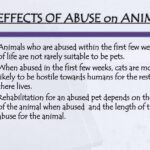In the intricate tapestry of justice, the threads woven through the laws surrounding animal cruelty illuminate the stark realities faced by countless innocent beings. In the United States, animals are often seen as silent witnesses, their suffering echoing in the halls of legislation. Various states, including Illinois, exhibit diverse approaches to dealing with those who perpetrate acts of cruelty against animals. The prison time for animal cruelty is, therefore, not just a matter of legal stipulations but a reflection of society’s moral compass.
In Illinois, the landscape of penalties for animal cruelty is delineated by a spectrum of severity, akin to the varying hues of a sunset. Under the Animal Cruelty Law, intentional acts of cruelty are classified as felonies. This often involves severe mistreatment, which prompts judges to impose significant sentences, illustrating a societal commitment to protect its most vulnerable. First-time offenders may face a punishment ranging from one to three years in prison, a stark reminder that malicious acts yield tangible consequences.
Even more egregious actions, such as torture or mutilation of animals, elevate the severity of the crime. Such actions may lead an offender to face between three to five years behind bars. The law in Illinois asserts that, akin to a line drawn in sand, boundaries should not be crossed when it comes to respecting the sanctity of life—be it human or animal. This reflects a broader philosophical tenet: that cruelty towards one species often heralds a disregard for compassion across the board.
When stepping beyond the borders of the Prairie State, one discovers a patchwork of legislation that reveals the complexity of animal rights across America. Take California, for instance; its laws reflect a paradigm shift in public perception, recognizing the sentience of animals. In California, acts of animal cruelty can result in imprisonment for up to three years. The enhancement of penalties for repeat offenders serves as a cautionary tale, much like the warning signs placed along perilous mountain roads.
Conversely, in states like Texas, though there have been strides made with the passing of the state’s animal cruelty statute in recent years, the rigidity of sentences remains limited. An offender can expect minimal repercussions for acts deemed less severe, which, in essence, trivializes the ramifications of cruelty. This discrepancy in legal treatment beckons a rousing discussion on the necessity of reform—a clarion call for justice that resonates within the hearts of animal advocates.
Then there’s New York, where legislation takes a commendable approach toward defining animal cruelty. The law enforces a maximum of two years in prison for such acts. The notion that a mere flicker of compassion should command the highest moral ground echoes through the byways of this bustling state. The law further defines degrees of cruelty, allowing for a nuanced understanding that seeks true justice for afflicted creatures.
However, one must also consider states like Florida, where the legal landscape unveils a stark contrast. Penalties for animal cruelty can hover around a mere five-year incarceration under the worst conditions, highlighting an overarching need for comprehensive legislative reform. Such disparities not only perplex but also infuriate those with the fervor to protect animals, unveiling the shades of injustice that prevail in these systems.
The intrinsic value of awareness must not be understated. The statistics surrounding animal cruelty are alarming. The act of tethering an animal for extended periods, leading to physical and mental strain, remains a pervasive issue. These acts, often cloaked in ignorance, speak to a larger narrative—one of a society that must awaken to the urgent need for reform and enlightenment on the ethical treatment of animals.
As we delve deeper into the heart of animal rights, it’s essential to recognize the role of advocacy organizations. These groups, much like unsung heroes, amplify the voices of the voiceless. They lobby for stiffer sentences, aiming to shift the paradigm toward stronger protections for our animal companions. The rallying cry for justice echoes in the chambers of congress, underscoring the belief that to live justly is to act with compassion.
Moreover, the conversation surrounding animal cruelty sentences extends beyond mere incarceration. Rehabilitation of offenders is equally pivotal. Engaging in community service, education about animal welfare, or psychological counseling can instill a newfound sense of empathy. Such initiatives could alter the trajectory of offenders, transitioning them from a state of ignorance to one of enlightened guardianship—whereforth they may become advocates instead of abusers.
As time unfolds its narrative, the evolution of our legal guardianship over animals remains an imperative conversation, echoing the collective conscience of society. The journey toward enhancing prison time for animal cruelty in Illinois and beyond is less about vengeance and more about forging a compassionate future for all beings. Compassion is the essence that should bind us, creating a world where animals are not merely viewed as possessions, but as sentient beings deserving of empathy and protection.
Throughout this vital pursuit, let us remain vigilant and unwavering, invoking a higher standard of treatment that will reverberate through time, creating a better tomorrow, rooted in kindness and resilience. While laws may evolve, the fundamental principle remains steadfast: cruelty, in any form, must be met with unwavering condemnation, as we collectively strive for justice in the face of darkness.







